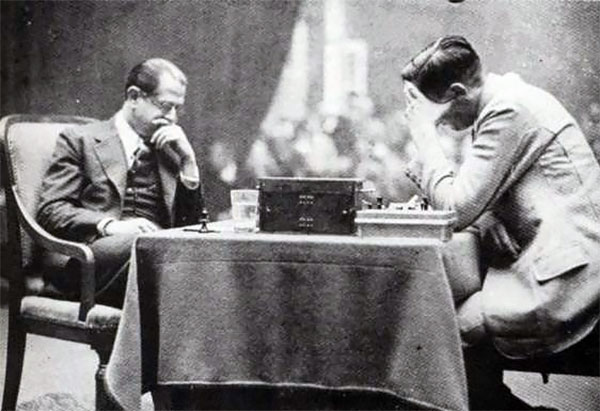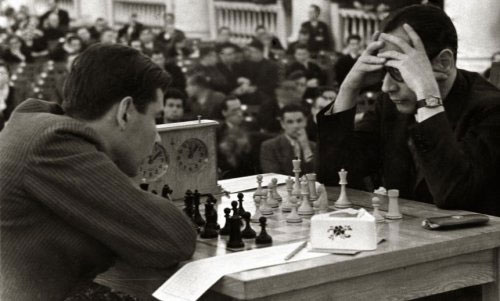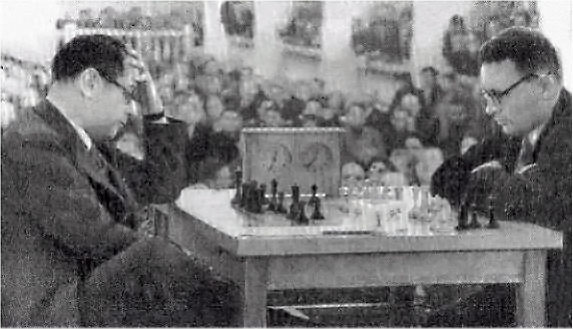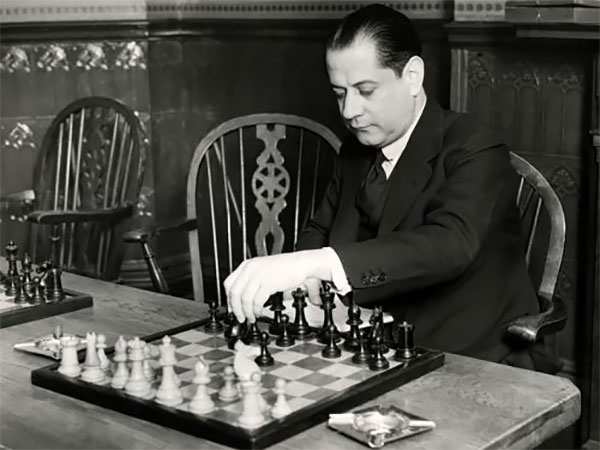By Alexander Yermolinsky
Capablanca lost his World Championship title to Alekhine in an epic battle in Buenos Aires in 1927. It took Alekhine 34 games to reach the required six wins in a monumental upset. Thirty-one of those thirty-four opened with the Queen's Gambit Declined. Capa vented his frustration by declaring the game of chess "dead" because the best ways of playing it had already been found and demonstrated during the match. Then he sailed for Europe where he played one tournament after another obviously trying to drum up some public support for the return match.
In spite of declaring the game “dead” he had clearly decided he needed to shake things up, and it was a bit of a shock to his rivals when he began playing the Nimzo-Indian. What? The Nimzo? Capa had never played it when he was Champion, although he did have a few wins on the black side of the Queen's Indian Defense, including a crushing one over Alekhine himself in the opening round of the 1927 New York Tournament.
Yet, from his first appearance as Former Champion in Bad Kissingen 1928 Capa made the opening named after one of his rivals his own mainstay defense against 1. d4. Some quick learning from a man who was rumored not to keep a chess set in his house....
Hans Kmoch vs José Raúl Capablanca (Budapest 1928)

[Event "Budapest"] [Site "Budapest"] [Date "1928.??.??"] [Round "?"] [White "Kmoch, Hans"] [Black "Capablanca, Jose Raul"] [Result "1/2-1/2"] [ECO "E24"] [Annotator "Alexander Yermolinsky"] [PlyCount "73"] [EventDate "1928.??.??"] [EventType "tourn"] [EventRounds "9"] [EventCountry "HUN"] [SourceTitle "HCL"] [Source "ChessBase"] 1. d4 Nf6 2. c4 e6 3. Nc3 Bb4 4. a3 {The Saemisch Variation before Fritz Saemisch himself played it - see below.} Bxc3+ 5. bxc3 b6 6. Qc2 $6 {This was not seen often in the next 89 years, and I wonder why. The engines seem to like this move.} Bb7 7. f3 d6 ({I guess, the answer is} 7... d5 8. cxd5 exd5 9. Bg5 ({The objectively better} 9. e3 {brings up a reference to the classic game Botvinnik-Capablanca, AVRO 1938, but the future World Champion never put his queen on c2.}) 9... O-O 10. e3 Re8 11. Bb5 c6 12. Bd3 h6 13. Bxf6 Qxf6 14. Kf2 c5) 8. e4 e5 9. Bd3 c5 {Looks very much in the spirit of Nimzo's own concept - a dark square blockade of the white center.} 10. Ne2 Nc6 11. Be3 Qe7 12. O-O O-O-O $5 {Very original. I recall some games from the Leningrad, 4.Bg5 variation where Karpov would send his king to the Q-side, albeit only after the center was closed by d4-d5.} ({Which is exactly what white would do in reply to the conventional} 12... O-O 13. d5 $1 Na5 14. Ng3 Ba6 15. Qe2 { the c4-pawn is safe, and White is ready to roll on the K-side. In a more modern interpretation of such structures Black prefers his knight on e7 (the Huebner Variation), and he often delays castling.}) 13. a4 Na5 14. Nc1 $1 { Hans Kmoch was not a bad player. Here he immediately hits on the right plan} Kc7 $1 {Prophylaxis? Black covers the b6-pawn before it comes under attack. Did Capa have a copy of "My System" packed for his transatlantic cruise? It hadn't been written yet...} 15. Nb3 Nxb3 16. Qxb3 a5 $1 {Absolutely necessry to stop White from opening the a-file, and only made possible by Black's clever 14th move.} 17. Bg5 $1 {This whole game unfolds like a dream.} Bc6 18. Rab1 Rb8 19. dxe5 dxe5 20. f4 h6 {Just a little bit careless. Capa didn't see the exchange sac coming.} ({Otherwise, he could have gone} 20... Qe6 {with more than a satisfactory position.}) 21. Bh4 exf4 (21... Rhd8 22. fxe5 Rxd3 23. exf6 Qxe4 24. Qc2 gxf6 25. Rbe1 Qxc4 26. Bg3+ Rxg3 27. hxg3 {favors White.}) 22. Rxf4 g5 23. Rxf6 Qxf6 (23... gxh4 24. Rbf1 Rhf8 {may have been the right call, but a tough one to make.}) 24. Bg3+ Kd7 25. Rf1 $5 {Kmoch rightfully ignores Rb8, judging his bishop more important.} ({He would have done even better by temporary blocking the diagonal with} 25. e5 $1 {to get the other bishop involved. Then} Qe7 26. Bf5+ Ke8 27. e6 fxe6 28. Bg6+ Kd7 29. Rd1+ Kc8 30. Bxb8 Kxb8 31. Qxb6+ Qb7 32. Qxc5 {looks like a mop-up job for White.}) 25... Qg7 {I bet a thought along the lines of " I never used to get into such a mess in my Queen's Gambit games" must have crossed Capa's mind.} ({Better was } 25... Qe7 {where} 26. Be2 {may be answered with} Qxe4) 26. Be2 $1 Ke7 27. Bh5 f6 (27... Rb7 28. Rxf7+ Qxf7 29. Bxf7 Kxf7 30. Qd1 Re7 31. Qd6 Bxe4 32. Qxb6 Rb7 33. Qxc5 Rd8 34. Bd6 {White's still better, but not decisively so.}) 28. Bxb8 Rxb8 29. e5 ({With the black queen out of play,} 29. Qd1 Rd8 30. Qb1 { was totally winning.}) 29... fxe5 30. Rf7+ Qxf7 31. Bxf7 Kxf7 32. Qd1 Re8 33. Qd6 Re6 34. Qc7+ Kg6 35. Qc8 {Amnesty. I guess Capa's reputation as infallible still held in Kmoch's mind.} (35. Qxb6 e4 36. Kf2 e3+ 37. Ke1 {would be a certain win for White.}) 35... Kf7 36. Qc7+ Kg6 37. Qc8 1/2-1/2
The following game shows what Capablanca learned from the near disaster against Kmoch.
Paul F. Johner vs José Raúl Capablanca (Karlsbad 1929)
The next game is known for its big Oops. Perhaps the most atrocious blunder in Capablanca's entire career. Still, it was his second Nimzo-Indian in Karlsbad 1929.
Fritz Saemisch vs José Raúl Capablanca (Karlsbad 1929)

[Event "Karlsbad"] [Site "Karlsbad"] [Date "1929.??.??"] [Round "?"] [White "Saemisch, Fritz"] [Black "Capablanca, Jose Raul"] [Result "1-0"] [ECO "E24"] [Annotator "Alexander Yermolinsky"] [PlyCount "21"] [EventDate "1929.??.??"] [EventType "tourn"] [EventRounds "21"] [EventCountry "CZE"] [SourceTitle "HCL"] [Source "ChessBase"] 1. d4 Nf6 2. c4 e6 3. Nc3 Bb4 4. a3 Bxc3+ 5. bxc3 d6 $6 6. f3 e5 7. e4 Nc6 8. Be3 b6 9. Bd3 Ba6 $4 (9... Na5 10. Ne2 Ba6 11. Ng3 c5 12. d5 h6 (12... h5 13. Bg5) 13. Qe2 $14) 10. Qa4 Bb7 11. d5 {And just like that the knight is gone. He tried hard to save the game, but the odds were unsurmountable and White won on move 62.} 1-0
It was perhaps a shot of confidence to the opening's creator since Aron Nimzowitsch would ultimately score the greatest victory of his career, taking clear first, just a half point ahead of Capablanca himself. It was a time of manly-man tournaments, and Nimzowitsch scored 15.0/21, to Capa's 14.5/21. That's right, it was a 22-player round-robin.

Just for the record, here is the mammoth crosstable. Click on it to see the full thing.
The next game, played in 1931, featured a Queen's Indian Defense, an opening that seemed to suit Capablanca better, judging from his results. In it, he found a great improvement against a trick that had been plaguing Black until then.
Max Euwe vs José Raúl Capablanca (Amsterdam 1931)

[Event "Amsterdam m3"] [Site "Amsterdam"] [Date "1931.??.??"] [Round "8"] [White "Euwe, Max"] [Black "Capablanca, Jose Raul"] [Result "1/2-1/2"] [ECO "E16"] [Annotator "Alexander Yermolinsky"] [PlyCount "112"] [EventDate "1931.??.??"] [EventType "match"] [EventRounds "10"] [EventCountry "NED"] [SourceTitle "HCL"] [Source "ChessBase"] 1. d4 Nf6 2. c4 e6 {What about other systems? Capa had done very well with the Queens Indian Defense.} 3. Nf3 b6 4. g3 Bb7 5. Bg2 Bb4+ {being his favorite line.} 6. Bd2 Bxd2+ 7. Qxd2 (7. Nbxd2 O-O 8. O-O c5 9. dxc5 bxc5 10. Rc1 $6 Qc7 11. Nb3 $2 d6 12. Qd2 Nc6 13. Rfd1 Rfd8 14. Nh4 a5 $15 {Marshall-Capablanca, New York 1931 0-1 (36)}) 7... O-O 8. Nc3 Ne4 9. Qc2 Nxc3 {[#] In his match against Euwe in 1931 he found a great idea to offset White's typical trick} 10. Ng5 $5 {and it stands to this day as Black's best option:} Ne4 $1 11. Bxe4 Bxe4 12. Qxe4 Qxg5 13. Qxa8 Nc6 14. Qb7 Nxd4 15. Rd1 Qe5 ({Two games later came an improvement:} 15... c5 $1 16. e3 Nc2+ 17. Kd2 Qf5 18. Qg2 Nb4 19. e4 Qf6 20. Kc1 Nxa2+ ({more energetic is} 20... b5 $5 21. a3 (21. cxb5 c4) 21... Nc6 22. cxb5 Nd4 23. f4 Rb8 {but this would be more up Alekhine's alley than Capa's.}) 21. Kb1 Nb4 22. Rxd7 Nc6 23. f4 e5 {and Black held a draw in Game 10.}) 16. e3 Nc2+ 17. Ke2 d5 18. Rd2 Qxb2 19. cxd5 Qb5+ 20. Kf3 {White's clearly better here, but Euwe's technique was not up to the task.} Nb4 21. Rc1 (21. Qxc7 Nxd5 22. Qc2 $16) 21... Qa5 (21... Nxd5 $1 22. e4 Qb4 23. Rdc2 f5 $1 {was another tactical miss by Capa. He used to be much sharper in his 20's and 30's...}) 22. d6 cxd6 23. Rc8 g6 24. Rxf8+ Kxf8 25. Qc8+ Ke7 26. Qc7+ Kf6 27. Qc3+ Ke7 28. Qc7+ Kf6 29. Qd8+ Kg7 30. Qxd6 Nxa2 31. Qd4+ e5 32. Qd5 Qxd5+ 33. Rxd5 e4+ 34. Kf4 Nb4 35. Rb5 (35. Rd4 a5 (35... Nd3+ 36. Kxe4 Nxf2+ 37. Kf3 Nh3 38. e4 Ng5+ 39. Ke3 Ne6 40. Rd7 $18) 36. Kxe4 b5 37. Rd7 a4 38. Ra7 {and the pawns are bound to fall.}) 35... Nd3+ 36. Kxe4 Nxf2+ 37. Kd4 f5 38. Rb2 Ng4 39. h3 Nf6 40. Rc2 Ne4 41. g4 Kf6 42. gxf5 Kxf5 43. Rc7 Ng5 44. Rxa7 h5 45. Ra3 Nf3+ 46. Kd3 $2 (46. Kd5 {should still win}) 46... Ng1 47. Kd2 g5 48. Rb3 h4 49. Rxb6 Nxh3 50. Ke2 g4 51. Rb5+ Ke4 52. Rb4+ Kf5 53. Kf1 Kg5 54. Rb5+ Kg6 55. Rb4 Kh5 56. Rb5+ Ng5 1/2-1/2

Capablanca played a 10-game match against Euwe in 1931, winning 6.0 - 4.0
Nikolay Nikolaevich Riumin vs José Raúl Capablanca (Moscow 1935)

[Event "Moscow"] [Site "Moscow"] [Date "1935.??.??"] [Round "1"] [White "Riumin, Nikolay Nikolaevich"] [Black "Capablanca, Jose Raul"] [Result "1-0"] [ECO "E37"] [Annotator "Alexander Yermolinsky"] [PlyCount "58"] [EventDate "1935.02.??"] [EventType "tourn"] [EventRounds "19"] [EventCountry "URS"] [SourceTitle "HCL"] [Source "ChessBase"] 1. d4 Nf6 2. c4 e6 3. Nc3 Bb4 4. Qc2 d5 5. a3 Bxc3+ 6. Qxc3 Ne4 7. Qc2 c5 8. dxc5 Nc6 9. e3 Qa5+ 10. Bd2 Qxc5 ({Today's players view} 10... Nxd2 {as more reliable:} 11. Qxd2 dxc4 12. Bxc4 Qxc5 13. Rc1 Qe7 $11 {where two high profile games Morozevich-Karjakin, 2009 and Eljanov-Kramnik, 2010 ended as wins for Black.}) 11. b4 Qe7 12. Bc1 a5 13. b5 Ne5 14. Bb2 Ng4 15. Nh3 Qh4 $6 {This is where Capa went wrong.} (15... O-O 16. Be2 e5 17. O-O Ngf6 18. f4 Bxh3 19. fxe5 Ng4 20. cxd5 f5 $1 {with unclear consequences as seen in Ivanisevic-Almasi, 2007}) 16. g3 (16. Bxg7 Nxe3 17. Qd3 Nxf1 (17... Rg8 18. Qxe3 Rxg7 19. cxd5 exd5 20. Nf4 {looks better for White.}) 18. Bxh8 Nfd2 19. Rd1 dxc4 20. Qe3 f6 21. Rxd2 Nxd2 22. Qxd2 Qe4+ 23. Kf1 e5 {and the engines show all zeroes.}) 16... Qh6 17. Qe2 Ngf6 ({Black has to welcome the mess that might arise after} 17... e5 $1 18. f3 Nxe3 19. fxe4 Bg4 20. Qd3 dxe4 $13) 18. Nf4 O-O 19. Bg2 dxc4 $2 (19... g5 {had to be tried one way or another.}) 20. Qxc4 Nd6 21. Qd3 { The white bishops are raking up the board on long diagonals, the black queen is out of play, while his Q-side stay undeveloped. What a sad sight.} Rd8 22. Rd1 Nfe8 23. O-O (23. a4 {looks more clinical here.}) 23... a4 $1 {Good try.} 24. Ne2 $2 (24. Be5 f6 25. Bxd6 Nxd6 26. Qd4 e5 27. Qb6 {would be curtains.}) 24... Bd7 25. Nc3 {Suddenly as Black crawled his way back into the game there came the unfortunate} Ra5 $2 (25... Qh5 $11) 26. Qd4 Qg5 27. Qb4 b6 28. Rd2 $18 Bxb5 29. Rfd1 h6 {time forfeit.} 1-0

Riumin facing Capablanca in Moscow, 1936
Rather a poor effort by Capa, who missed a lot of tactics. I guess this is the real reason for his repeated failures on the black side of the Nimzo as age was catching up with him. One can throw in the more famous losses to Lilienthal, Hastings 1934-35 (remember the queen sac there?) and to Botvinnik in the AVRO tournament. Does it mean Capa made a wrong choice by abandoning his trusted QGD in favor of new ideas? Hard to tell, but the fact is, the following year, 1936, was arguably the most successful in Capa's post-Championship career. He notched two tournament wins shared with Botvinnik, in Moscow and, especially important, in Nottingham, along with a clear first in a smaller event in Margate. Throughout all this he never played the Nimzo, only QGD with some occasional Slavs. Go figure. He did however employ the Queen's Indian, which includes a famous win over Botvinnik in Moscow 1936, but that's another story.

One of Capablanca's famous wins, as he overcame the rising star Botvinnik in 1936, sharing first at Moscow











